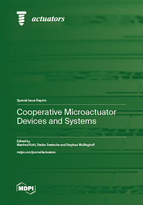Cooperative Microactuator Devices and Systems
A special issue of Actuators (ISSN 2076-0825).
Deadline for manuscript submissions: closed (30 June 2023) | Viewed by 17125
Special Issue Editors
Interests: smart materials; shape memory materials; piezoelectrics; magnetic materials; microtechnology; multistable microactuators; cooperative microactuators; intrinsic sensors
Special Issues, Collections and Topics in MDPI journals
Interests: smart material systems; actuators; sensors; dielectric elastomers; shape memory alloys; elastocalorics
Special Issues, Collections and Topics in MDPI journals
Special Issue Information
Dear Colleagues,
This Special Issue collects selected review papers from invited authors in the field of cooperative microactuators. Combining similar microactuators in microactuator arrays enables the control of time and spatially resolved actuation patterns, while the combination of microactuators based on different transducer principles even allows for novel process chains across different functional levels as well as several length scales. In addition to understanding and controlling the different synergies, various cross-coupling effects due to the close neighbourhood of microactuators have to be mitigated. This Special Issue will cover the topic of cooperative microactuator devices and systems based on electrostatics, electromagnetics, electroactive polymers, magnetic polymers, shape memory materials, and combinations thereof.
Prof. Dr. Manfred Kohl
Prof. Dr. Stefan Seelecke
Prof. Dr. Stephan Wulfinghoff
Guest Editors
Manuscript Submission Information
Manuscripts should be submitted online at www.mdpi.com by registering and logging in to this website. Once you are registered, click here to go to the submission form. Manuscripts can be submitted until the deadline. All submissions that pass pre-check are peer-reviewed. Accepted papers will be published continuously in the journal (as soon as accepted) and will be listed together on the special issue website. Research articles, review articles as well as short communications are invited. For planned papers, a title and short abstract (about 100 words) can be sent to the Editorial Office for announcement on this website.
Submitted manuscripts should not have been published previously, nor be under consideration for publication elsewhere (except conference proceedings papers). All manuscripts are thoroughly refereed through a single-blind peer-review process. A guide for authors and other relevant information for submission of manuscripts is available on the Instructions for Authors page. Actuators is an international peer-reviewed open access monthly journal published by MDPI.
Please visit the Instructions for Authors page before submitting a manuscript. The Article Processing Charge (APC) for publication in this open access journal is 2400 CHF (Swiss Francs). Submitted papers should be well formatted and use good English. Authors may use MDPI's English editing service prior to publication or during author revisions.








